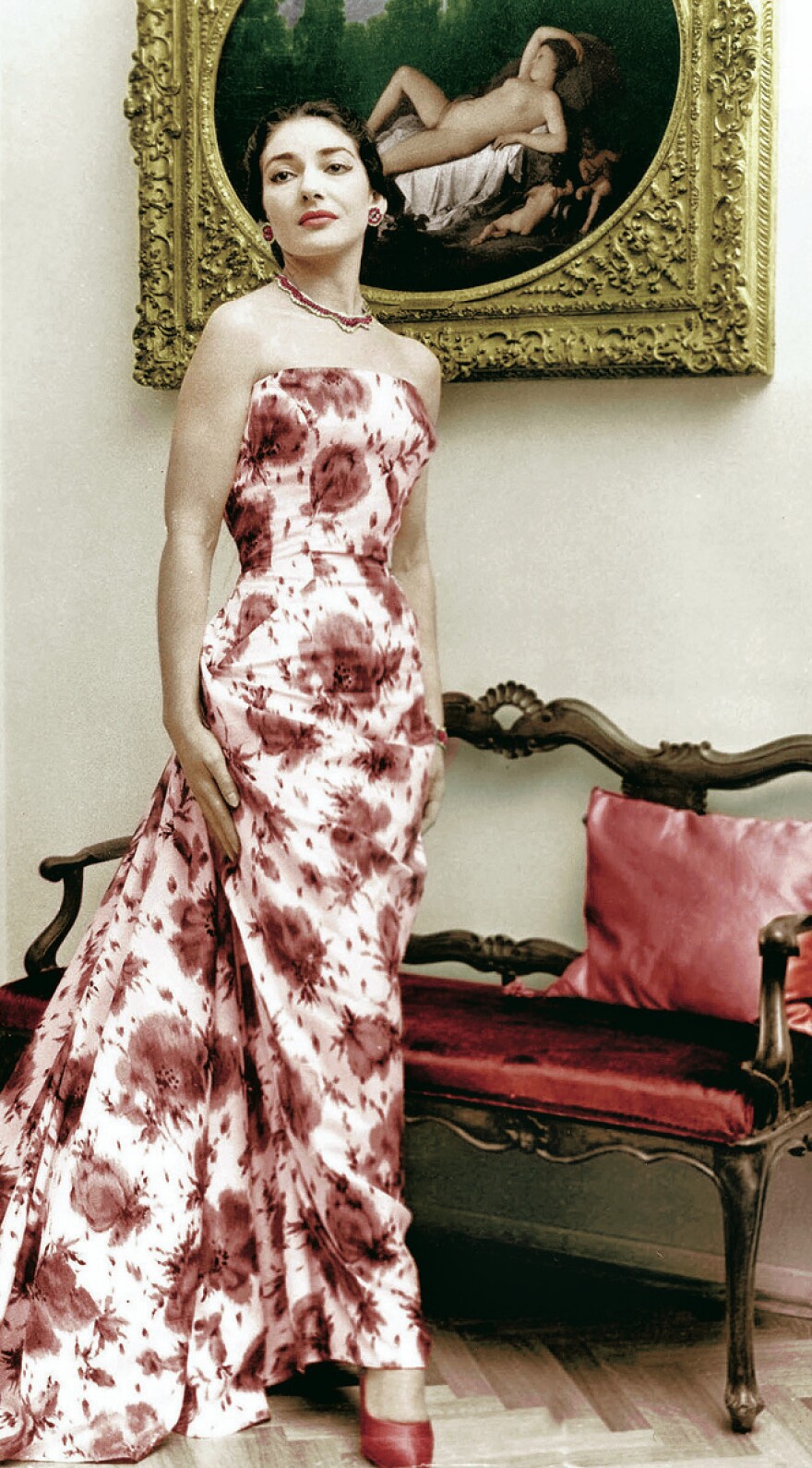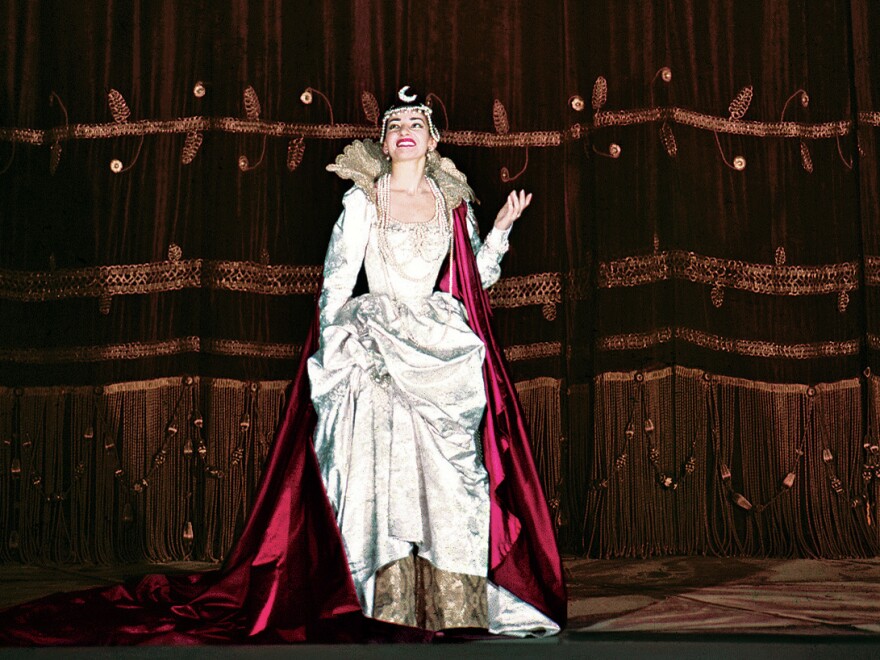As far as flashy, oversize coffee table books go, opera star Maria Callas is a fitting subject. A larger-than-life figure, she had a complicated off-stage story that played out with as much searing drama as the operas she sang. With hard work and sacrifice, Callas vaulted to the top of her art while pushing it to new levels of intensity. In her personal life, she searched for love, found it, then lost it and died young.
Photographer and film maker Tom Volf (with publisher Assouline) has just released a gorgeous new photo book, Maria by Callas. It is a loving and luxuriously upholstered tribute to one of the most fascinating artists of the 20th century. Its publication marks the 40th anniversary of the soprano's death, which falls on Sept. 16.
Volf came late to the Callas bandwagon. But once he discovered the controversial singer, he was moved to begin a journey that led him around the world, interviewing Callas' friends and colleagues and gathering photographs and other materials along the way. The book, which weighs in at more than seven pounds with its satin cover and deluxe slipcase, includes photos never before published. But more importantly, the ones we've seen before have never looked better. Volf also has a documentary film about Callas on the way, and he says that a batch of rarely heard Callas recordings will be reissued in the fall
Our conversation below has been edited for length and clarity.
Tom Huizenga: Every Maria Callas fan seems to have a story about how they first discovered her. What's your story?

Tom Volf: My story, I guess, is a pretty modern one. I discovered her through YouTube. It was in January 2013, and I was in New York. I just had come back from my very first opera at the Met, which was Donizetti's Maria Stuarda with Joyce DiDonato singing, and I had a complete shock when I came back home. I was looking to find out more about who was this Donizetti who gave me such a shock, and very quickly found, on YouTube, Maria Callas' "Mad scene" from Lucia di Lammermoor, and that was a true revelation. I think that was at about 2 a.m., and I probably spent the rest of the night on YouTube listening to any other pieces I could find. That was my first Callas encounter.
What did you find so special about her at the beginning, because the voice actually is not always beautiful, at least by conventional standards?
I was coming not at all from the operatic world. I had no technical comparison or standards. The only thing I could see and feel was something incredible, indescribable, passing through me when I was listening to her. And I think it was a blend of discovering at the same time — and for the first time — some of these magnificent pieces with such incredible melodies that were taking me completely to another world. I didn't know the operas, I was a complete novice. But there was something going through my whole body and my heart. It made me want to cry, and it was a very strange experience to describe. I could only feel what was happening to me. And I couldn't get enough of it. It was like a drug.
Right. By the way, I also attended that run of Maria Stuarda with Joyce DiDonato, which was an extraordinary performance.

I think if I had not been at that performance, I may have never really discovered opera and fell in love with opera, and fell in love with Maria Callas.
So what was the "light bulb moment" for you, the one that sent you on this three-year journey to learn all you could about Maria Callas?
Well, it wasn't a moment where I suddenly decided, "I'm going to start a three-year journey on Callas." It was actually very much of a process. There was that "aha" moment that night, and that is still very vivid for me.
I spent weeks after that listening and learning all I could about her. And you know, YouTube was a great vector for me. I connected with people around the world who were posting excerpts of her various performances. Through that, I learned a lot. And then throughout this process of learning and getting myself into this world, and getting all excited about it, I realized two things. One very quickly: It was a phenomenon that someone who had passed away almost 40 years ago was still so well-known all around the world — no country boundaries, no age boundaries, a transcendence of time and space. It made me want to understand how such things could happen. Secondly, in my process of learning about her, I devoured every book and every documentary. And having watched and read all that, I still couldn't get a true feel of who she really was — who she truly was as a woman, who she truly was as an artist. I only felt I was getting glimpses from people talking about her and writing about her. The moments that were the most striking to me were the moments when she was speaking.
From that frustration the journey was born, and I started, step by step, of going to find and meet every possible person still alive who really knew her. Of course, I had no idea I would get so far and that it would take me almost four years.

You say in the forward to the book that you felt it was your duty to share the emotion that you felt when you first started listening to Callas. What was that emotion?
I think it's even so much more than an emotion. It was in a dark, difficult time of my life, and something was coming from out of this world and bringing me elsewhere — but also uplifting me, giving me hope, giving me joy. The suffering that you can feel sometimes through her interpretation of tragic roles as Norma or Traviata, I could relate to it. It was also a catharsis because it allowed me to feel entirely these emotions. I felt there was very much a serendipity, or destiny, in the fact that I would discover Callas right at that time. And again, I was not an opera fan or anything. I was not coming from that world at all but somehow something happened. If she was able to comfort me in that way and bring me such emotions and such beauty into my life, I wanted to contribute somehow to making this happen for others.
What was one of the most surprising or extraordinary things you discovered on this Callas adventure?
There were a lot. But one that really was striking for me was that I discovered an unknown interview that someone had preserved and in that interview, which has never been heard since it was recorded in 1970, she said something that really struck me. She said, "There are actually two people in me. There is 'Maria' and there is the 'Callas' that I have to live up to."
To understand that there were actually two personalities in her — and that it was a constant battle between the two. It took me time to understand that for all her life, she sacrificed one for the other. I think that was her biggest struggle, and that explains so much about her personality both as a woman and as an artist.

Maria the woman and Callas the artist: They were sometimes at odds with each other. But I think your book leans a little more towards Maria the woman, focusing not so much on the operatic stage photos but more on the personal images, and the considerable glamour. I think it's even borne out in your title, which is Maria By Callas — and that you really let her speak her own words.
Well that was my intention from quite early on. I decided that all of the projects that I'd be working on would not be in my own voice, not someone else again talking about her. But on the contrary, I saw myself as a messenger and a vehicle that could, for the first time, put her own voice in the center and allow her to convey her own sentiments.
I mean, it is Maria By Callas because Maria was a very private person. She really didn't show much of herself as a woman in the various public appearances or interviews. I think people have very little knowledge about what her life was like. And therefore, when you see her in these incredible personal pictures of her on holiday, or on the beach with her friends, you have the feeling of a very different woman.

Then there's the 40-year-old question: Why did she die so young? Yes, she supposedly had a little problem with pills, but 53 is not very old.
I personally don't believe much of what has been said about the pills or anything because I can only rely on what I was told by direct witnesses. The truth is on that day, September 16, 1977, there were only two direct witnesses. There was Ferruccio, her butler, and Bruna, her maid. And I was very fortunate to meet and become friends with both of them. And they have recounted for me very vividly what happened that day. And, very briefly, what happened was a heart attack.
Fame, in our modern times, is a boomerang, and every artist, if he is true to himself, in his work, is particularly vulnerable
There could be several reasons. She had gone through the war; she had poor health in the beginning. She had a crazy, intense life. And I think this may be less of a mysterious and strange story than it actually is. The truth is she died from a heart attack.
Some say she also died of a broken heart, after her one true love, Aristotle Onassis, left her for Jackie Kennedy.
I would totally agree with that because she did die one year and a half after [Aristotle] Onassis, who I believe was truly the greatest love of her life.
Why do we keep revisiting Callas? Almost every year, her record company reissues her recordings and there have been at least two movies about her — a documentary and Franco Zeffirelli's bio-pic Callas Forever -- and then Terrence McNally's play Master Class. Why does she still matter to us?
As I said in the beginning, why is she still so well-known, and continues to interest a whole new generation who has never been to her performances? She still has something fascinating, and I think there is a mystery to that.
But I can say personally that I am a big advocate of revisiting because when I was discovering her — and I saw the movies and everything — it didn't really give me any insight into who she was. I kept coming back to her music and to her interviews.
I mean, she can be revisited 100 times and a lot of things can be invented about her. But it's much more interesting to find out the truth. Because if you find out the truth about her, you'll find it in her singing. She said herself, "It's all in my music." That's the beauty of understanding who she was as a woman and who she was as an artist. And that's what matters in the end. It's not the gossip and the love stories. It's her art because that is what is so unique about her.
Copyright 2023 NPR. To see more, visit https://www.npr.org.





